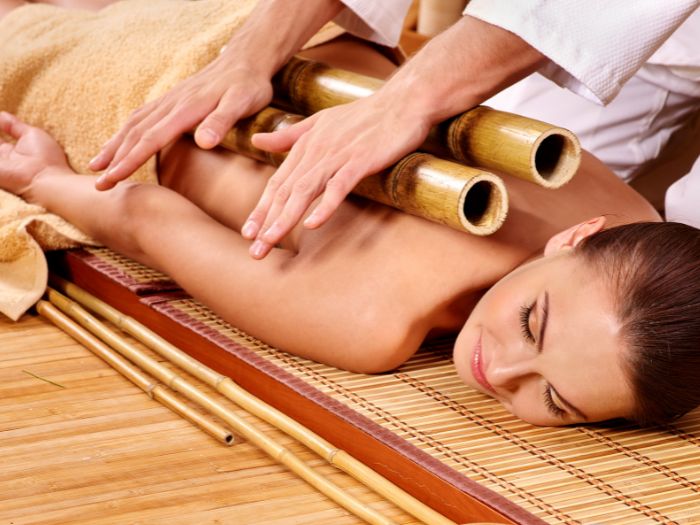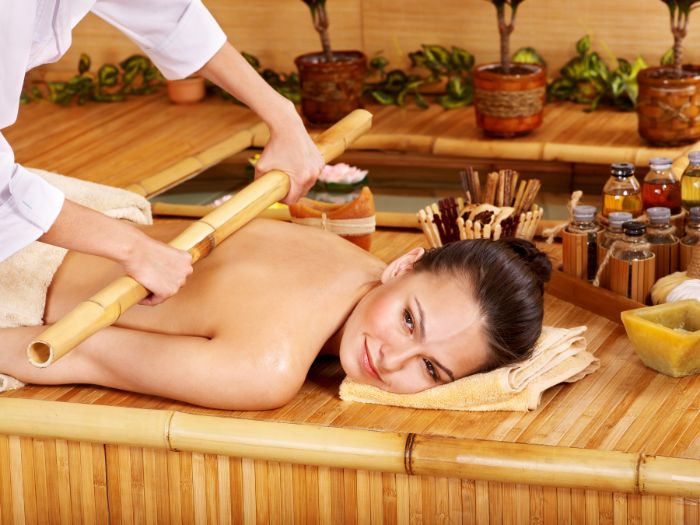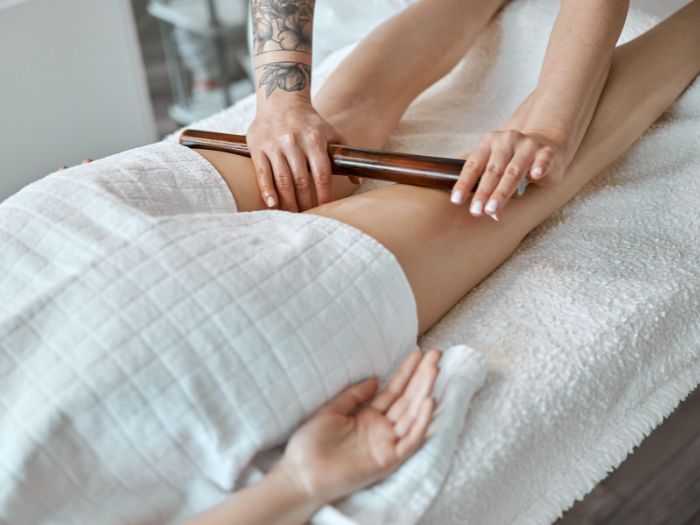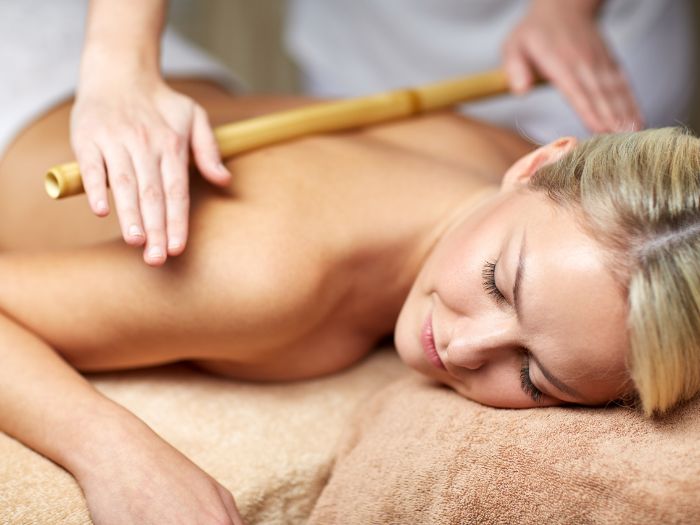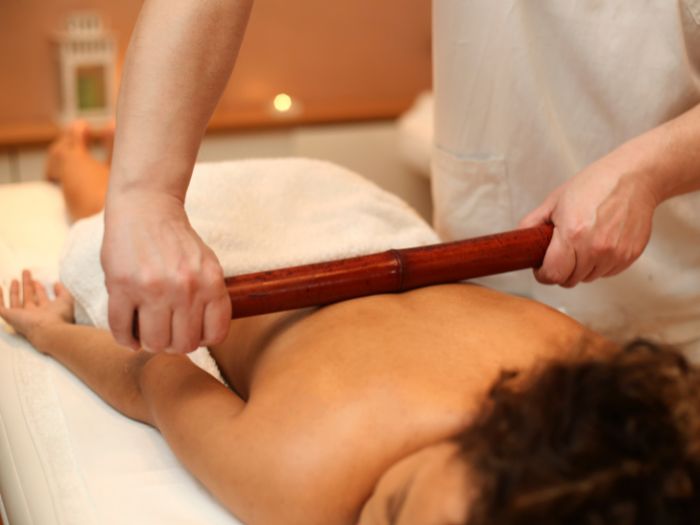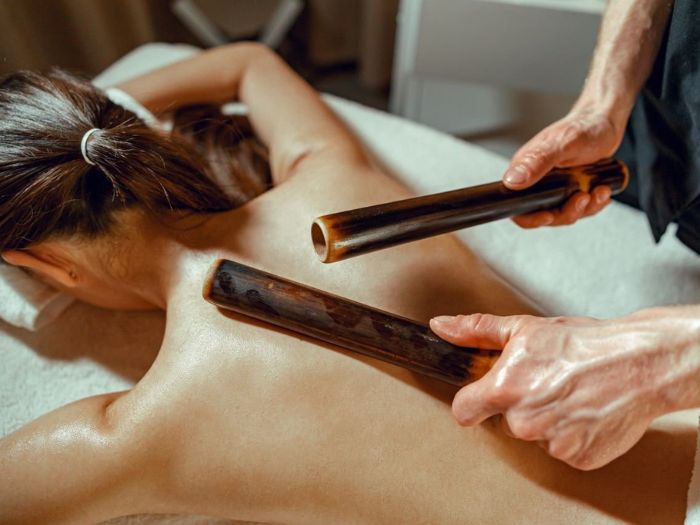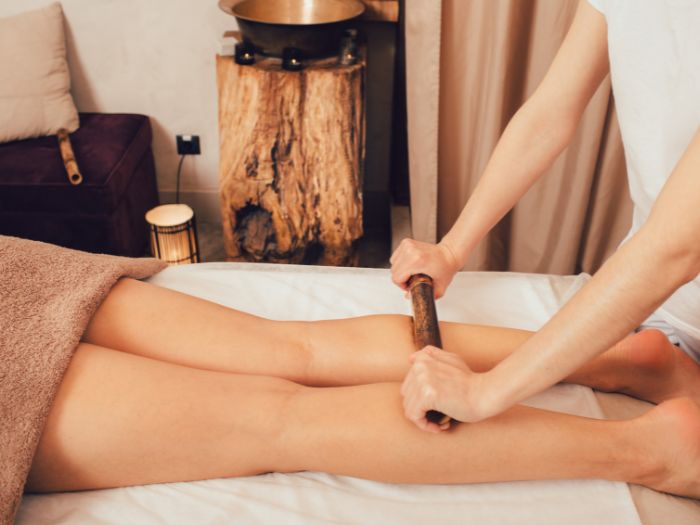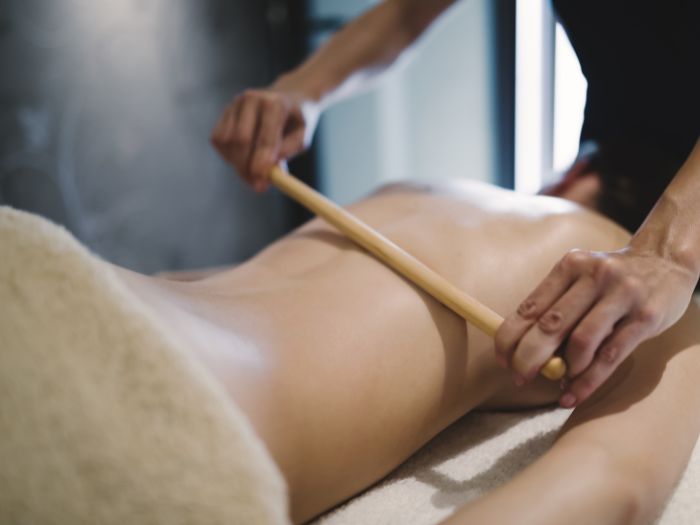The Art of Bamboo Therapy
The Bamboo Massage Course offered by our massage school in Bangkok is a specialized training designed to equip students with a unique, dynamic, and effective massage technique that blends ancient tradition with modern therapy. Bamboo massage, known for its power to relieve deep muscular tension and stimulate energy flow, uses smooth, warmed bamboo sticks of various sizes to deliver flowing, rhythmic strokes that both relax and energize the body.
This course is designed for both beginner and professional massage therapists who want to expand their skillset, explore alternative tools, and enhance the effectiveness of their treatments. Bamboo massage is particularly valuable for clients who prefer deep tissue work but need it delivered in a more fluid, less intrusive manner. The method helps reduce physical effort for the therapist, improves circulation, and offers a luxurious yet therapeutic spa experience.
Students will also learn how to integrate Bamboo Massage with Herbal Compress, Hot Stone, Aroma Oil Massage, and Tok Sen Massage to create deeply relaxing and effective treatments.
More than just a massage course, this is an invitation to step into a deeper connection with nature, movement, and the healing energy of touch. Whether you are looking to add a new specialty to your repertoire or build a professional practice grounded in innovation and tradition, this course will guide you with confidence.
Bangkok and Sukhumvit – A Global Wellness Destination
Training in Bangkok, especially in the district of Sukhumvit, offers an enriching environment for aspiring wellness professionals. Bangkok is known worldwide as a center for Thai healing, traditional medicine, and alternative therapies. In this vibrant capital city, massage is not just a service—it’s a respected cultural heritage. From the back alleys of ancient temples to the modern high-rises housing five-star spas, Bangkok is the place where ancient wisdom and contemporary wellness come together.
Our school is located in Sukhumvit, one of the most international, energetic, and wellness-oriented districts in the city. Easily accessible by public transport and filled with cultural diversity, Sukhumvit is home to luxury spas, boutique hotels, health cafés, yoga studios, and traditional massage centers. It’s a neighborhood that reflects the global evolution of Thai massage and wellness education. Training in Sukhumvit places you in the heart of an ever-growing professional network and offers the ideal blend of comfort, culture, and creativity.
The Story and Origin of Bamboo Massage
Bamboo massage draws its inspiration from traditional Asian healing practices, where bamboo has long been revered for its strength, flexibility, and symbolic significance. In many Eastern cultures, bamboo represents resilience, growth, balance, and inner strength. These same qualities are reflected in the massage technique itself—firm yet fluid, strong yet gentle.
The use of bamboo in massage has been practiced in various cultures, including in China, Japan, India, and Southeast Asia, where therapists used natural tools such as sticks and stones to improve circulation and balance energy flow. In modern spa culture, bamboo massage has gained popularity as a luxurious deep tissue technique that not only delivers results but also creates a unique sensory experience.
In this course, we maintain a respectful connection to the origins of bamboo massage while teaching a professional, results-driven technique that combines rhythm, pressure, and intuition.
Course Preparation and Setting
The course begins with a grounding in the philosophy and structure of bamboo massage. Students are invited to enter the training space with an open mind, a readiness to move, and a respect for the tools and bodies they will work with. Classes take place in a calm, fully equipped learning environment designed to emulate real spa settings.
Students are asked to wear comfortable Thai-style massage clothing—loose, breathable fabrics that allow full range of motion during the practice. Since the massage involves rhythmic body movement, posture, and tool handling, ease of motion and flexibility are essential for both comfort and effectiveness.
All bamboo massage equipment is provided by the school, including various sizes of bamboo sticks, massage oils, towels, and cleaning supplies. Each student will have a dedicated workspace, access to materials, and hands-on guidance from experienced instructors.
Understanding the Tools of Bamboo Massage
The primary tools used in bamboo massage are specially treated bamboo sticks, which are selected and prepared for smoothness, durability, and hygiene. They come in different lengths and thicknesses to accommodate various body areas and massage techniques.
- Smaller sticks are used for facial or neck work.
- Medium and large sticks are used for the back, thighs, and legs.
- Some bamboo sticks are curved to better follow the contours of the body.
- The sticks can be used warm or at room temperature, depending on the client’s preference and treatment goals.
Students learn how to:
- Hold and maneuver bamboo sticks with grace and control.
- Adjust pressure using both hands and body weight.
- Maintain even contact and rhythm.
- Sanitize and store the tools safely.
- Integrate bamboo strokes with traditional hand techniques.
Working with bamboo sticks allows the therapist to reduce physical strain, target deep muscle tissue, and deliver longer sessions with less fatigue.
Step-by-Step Training: The Dance of Bamboo Therapy
The training unfolds gradually, starting with the fundamentals and building toward full-body sequences. Each day includes a combination of theory, demonstration, and supervised practice, so students gain both intellectual and muscle memory of the technique.
Training starts with an overview of muscle anatomy, particularly areas where tension accumulates due to stress, lifestyle, or poor posture. The instructor explains how bamboo massage helps release tight fascia, stimulate lymphatic drainage, and restore muscular balance.
Phase 1: Posture, Grip, and Rhythm
Students learn how to position their bodies for optimal delivery, how to grip the bamboo correctly, and how to create a flowing rhythm with consistent pressure. These are the foundational elements that make bamboo massage feel both powerful and nurturing.
Phase 2: Back and Shoulder Sequence
This sequence is often the most satisfying for clients and therapists alike. Using medium to large sticks, students practice rolling, tapping, kneading, and pressure-gliding motions along the back, shoulders, and spine. This helps relieve chronic back pain, stimulate blood flow, and soften tight muscles.
Phase 3: Legs and Thighs
Working on the legs requires special attention to pressure and movement. The bamboo sticks allow therapists to deliver strong strokes without the fatigue that often accompanies manual deep tissue work. This phase also includes glute and hip work to improve mobility and relieve sciatica-like symptoms.
Phase 4: Arms, Hands, and Feet
Smaller sticks are used to stimulate the arms and feet, with careful attention to reflex zones and joint areas. This is particularly useful for clients who spend long hours on devices or standing.
Phase 5: Face and Neck (Optional Advanced Module)
A special module is offered for students who want to learn facial bamboo massage using mini bamboo tools. This focuses on lymphatic drainage, lifting, and relaxation, and is a beautiful add-on for spa treatments.
Students also learn how to blend bamboo work with traditional Thai or Swedish massage techniques, creating personalized treatments for their clients.
Contraindications and Safety Considerations
Bamboo massage, while generally safe and beneficial, must be practiced with full awareness of contraindications and client-specific needs. The course includes comprehensive instruction on safety protocols, screening clients, and adapting techniques.
Massage should be avoided or modified in cases of:
- Varicose veins or vascular conditions
- Skin infections, burns, or recent surgeries
- Fever, inflammation, or open wounds
- Severe osteoporosis or bone fragility
- Pregnancy (unless trained specifically in prenatal techniques)
- Recent bruising, fractures, or trauma
Students are taught how to adjust pressure, avoid sensitive areas, and prioritize the client’s comfort. Informed consent, clear communication, and constant feedback are emphasized throughout the training.
Benefits of Bamboo Massage – For the Client and Therapist
Clients receiving bamboo massage often report an immediate sense of relaxation, rejuvenation, and deep muscular release. The benefits extend beyond physical comfort and include:
- Reduction in muscle tension and knots
- Improved lymphatic drainage and detoxification
- Enhanced circulation and energy flow
- Relief from chronic stress and fatigue
- Skin revitalization due to improved oxygen supply
- A sense of groundedness and emotional release
For therapists, bamboo massage is a way to work smarter, not harder. It minimizes hand fatigue, allows for longer sessions, and offers a signature service that stands out in a crowded wellness market.
Recommendations for Students
To get the most out of this course, students are encouraged to engage in daily practice, reflect on their technique, and receive feedback from instructors and peers. Journaling your experience and progress can help internalize the rhythm and flow of bamboo work.
We also recommend observing or experiencing bamboo massage in a professional setting, which will help you develop your own style and understand what makes a treatment exceptional from a client’s perspective.
Students who combine bamboo massage training with Thai massage, aromatherapy, or spa therapy modules often build a more complete and versatile skill set.
What You Can Do After the Course
After completing this course, students will receive a Certificate of Training in Bamboo Massage, certifying their ability to deliver professional-level treatments.
Graduates may go on to:
- Work in spas, wellness centers, or luxury hotels
- Offer mobile or in-home bamboo massage services
- Create their own signature bamboo treatments
- Teach introductory bamboo massage workshops
- Combine bamboo massage with hot stone, herbal compress, or sports massage therapy
The technique is especially popular in spa environments seeking to offer unique, visually appealing, and highly effective treatments. Many therapists also find bamboo massage to be ideal for clients who enjoy strong pressure but cannot tolerate traditional deep tissue work.
Strength and Flow Through the Hands of Nature
The Bamboo Massage Course is an invitation to reconnect with the healing rhythms of nature, learn a physically sustainable massage technique, and expand your therapeutic impact in meaningful ways. It blends the wisdom of ancient traditions with the elegance of modern spa therapy, offering clients a deeply restorative experience and therapists a graceful, powerful modality.
Training in Sukhumvit, Bangkok, provides the perfect combination of cultural immersion, professional guidance, and wellness inspiration. Whether you are beginning your massage journey or looking to elevate your existing practice, bamboo massage offers a tool that speaks to the mind, body, and soul.
Please note: The contents of this course description are provided for general information and guidance. Actual training structure, duration, techniques, and learning outcomes may vary depending on each student’s background, physical ability, and personal learning goals. Our instructors adapt the course experience to ensure each participant gains the most from their training.
If you would like to experience the Bamboo Massage performed by a professional therapist, we highly recommend booking a session with our partner Loft Thai Boutique Spa & Massage. Their experienced team offers authentic treatments in a serene and luxurious setting. To explore and book your session, please visit the link below. All students from Nuad Thai School are entitled to an exclusive 20% discount on all treatments.
Pricing
Packages made for anyone!
Thai Discover
- 4-hours group course
- Instructor & Model
- Introduction & Theory
- Thai Massage Practice
- School Certification
Thai Beginner
- 4-hours private course
- Instructor & Model
- Introduction & Theory
- Thai Massage Practice
- School Certification
Thai Professional
- 150 hours private course
- Instructor & Model
- Professional Training Course
- Custom or Tailor-Made
- Official THAI UTTS Certification

